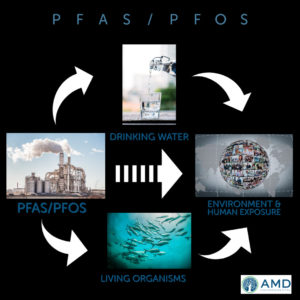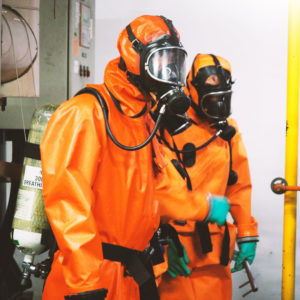The growing concern of PFAS: What you need to know
Per – and Polyfluoroalkyl Substances could prove to be one of the most enduring environmental issues of this century.
Known as “PFAS,” Per-and Polyfluoroalkyl Substances are increasingly becoming a concern to environmental scientists on a global scale. Commonly used in many consumer products, PFAS are dangerous to human health and biological communities (ecosystems).
What are PFAS and PFOS?
 PFAS, including Perfluorooctane Sulfonic Acid (PFOS), are environmentally harmful chemicals that do not break down in the environment or the human body. Dubbed “forever chemicals” due to their persistent nature, this group of manufactured chemicals are used in products that resist water, grease, and heat.
PFAS, including Perfluorooctane Sulfonic Acid (PFOS), are environmentally harmful chemicals that do not break down in the environment or the human body. Dubbed “forever chemicals” due to their persistent nature, this group of manufactured chemicals are used in products that resist water, grease, and heat.
Hundreds of chemicals in this category have been manufactured in various industries across the globe since the 1940s.
Where are PFAS found?
 PFAS are everywhere, so there is a global call to phase out their use and adequately dispose of the existing generation of chemicals.
PFAS are everywhere, so there is a global call to phase out their use and adequately dispose of the existing generation of chemicals.
The chemicals are found in industry and consumer products, including:
- non-stick cookware
- water-resistant clothing
- food packaging
- stain-resistant fabrics
- fire fighting foam
- cosmetics
- products that resist grease, water, and oil
The major problem is that PFAS do not break down and move easily through the soil, air, and water.
How are PFAS harmful to human health?
 Exposure to PFAS is highly harmful to humans because the chemicals cause immediate and long-term detrimental health effects. Studies show that exposure to PFOA – acid and PFOA – salt (also known as C – 8) directly harms body systems and causes cancer.
Exposure to PFAS is highly harmful to humans because the chemicals cause immediate and long-term detrimental health effects. Studies show that exposure to PFOA – acid and PFOA – salt (also known as C – 8) directly harms body systems and causes cancer.
Specifically, exposure to these chemicals negatively impacts human organs and body systems.
This includes:
- Liver and Kidney dysfunction
- Immune system disorders
- High cholesterol
- High Serum Uric Acid levels
Exposure to PFAS is linked to the following diseases:
- Kidney cancer
- Testicular cancer
- Ulcerative colitis
- Thyroid disorder
How do PFAS impact Ecological Systems?
 Ecological Systems (“ecosystems”) are biological communities that consist of living organisms and nonliving things. There are two major ecological systems: terrestrial (land-based) and aquatic (water-based) ecosystems.
Ecological Systems (“ecosystems”) are biological communities that consist of living organisms and nonliving things. There are two major ecological systems: terrestrial (land-based) and aquatic (water-based) ecosystems.
Ecosystems are healthiest when the environment is in homeostasis or balance. All things are interconnected and interdependent in an ecosystem, which is why PFAS are proving so harmful.
Exposure to chemicals is causing pathological plant and animal tissue anomalies. For example, scientists have identified tumors in fish and various diseases in living organisms.
The impact of PFAS on ecosystems is immediate, and the ecological exposure is far-reaching. These versatile chemicals disrupt healthy ecological systems in communities worldwide; however, there is a higher chance of contamination in areas near airports, military bases, and industrial sites.
Responsibility to test, identify, and mitigate forever chemicals
The growing concern over PFAS warrants a collective response from the professional environmental community. The need for professional collaboration is precisely why AMD Environmental Consultants and Brydges Engineering in Environment and Energy, DPC have combined resources and expertise to take the most comprehensive, integrated approach to identifying and remediating PFAS.
Anthony DeMiglio of AMD Environmental Consultants explains why an integrated, collaborative approach is necessary. He says, “Sometimes technological solutions of yesterday become environmental burdens today. It is our responsibility to not only mitigate issues created by these situations but also to make an effort to navigate a cleaner, safer future.”
The goal is to identify and survey building materials and products, sample and analyze environmental media and design a remediation plan that has minimal impact on human health and the environment. The emphasis is on minimizing exposure to the chemicals and safely securing contaminated areas. 
Once the initial sampling is complete, skilled environmental scientists will develop an action plan that complies with federal and local regulations.
Remediating PFAS requires an integrated approach, including advanced technology to remove PFAS and PFOS. Technicians will also need personal protective equipment. Engineers will need to devise treatment systems, and companies must be well-versed in government laws and regulations concerning PFAS.
As demand for increased environmental sampling continues to move upward, our team stands ready. Our environmental scientists are acutely aware of the responsibility placed on our shoulders. We are prepared to service industrial, commercial, and residential property owners in Western New York and the surrounding areas.
If you are a building owner or a homeowner, contact our professionals for a complete consultation and analysis of your property.

